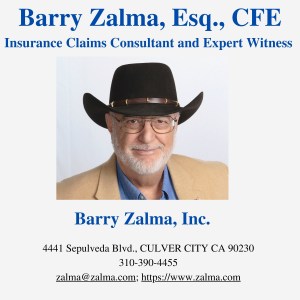Fictionalized True Crime

See the full video at https://rumble.com/v43auvt-fictionalized-true-crime.html and at https://youtu.be/xJ0jwx70HsQ
This is a Fictionalized True Crime Stories of Insurance Fraud from an Expert who explains why Insurance Fraud is a “Heads I Win, Tails You Lose” situation for Insurers. The story is designed to help Everyone to Understand How Insurance Fraud in America is Costing Those who Buy Insurance Thousands of Dollars Every year and Why Insurance Fraud is Safer and More Profitable for the Perpetrators than any Other Crime.
After twelve months trying to get insurance on over $3,000,000 in jewelry and a like amount of fine arts, a Taiwanese man who was a wanted criminal in his own country convinced two American insurers to agree to insure him against the risk of loss to the contents of his home.
To obtain the insurance he concealed from the American insurers that he was, at the time he purchased the insurance:
an alien a court had ordered deported;
that in his home country he was a wanted criminal;
that he had left his home country with over $60,000,000.00 in checks unpaid;
that every insurer at Lloyd’s, London had refused to insure him;
that all of his property was appraised for more than twice its actual retail replacement value; and
that most of the antiques he had insured in reliance on an “appraisal” attesting to a $3,500,000 value, were fakes.
His application gave the impression that he was a Beverly Hills, California investor with appropriate concerns for security. He also made it clear that he was willing to pay a high premium for the protection, a fact that should have raised the concern of the underwriters asked to accept the risk of loss of his property.
Within seven days of the delivery of his policy, a “burglary” was reported. A total of $7,000,000.00 of specifically identified and scheduled personal property was reported stolen. He claimed an additional $2,000,000 in unscheduled diamonds were stolen from their hiding place in one of his 50 suit coats hanging in his master bedroom closet.
The burglars had no problem effecting the burglary because the Insured was out of town. The burglars circumvented, what the insurers were told was a sophisticated central station alarm system, because it was merely a local gong type alarm that had never been turned on. They defeated the promised class E safe (one that requires at least 30 minutes to drill out the lock) with a simple wood drill since the actual safe was nothing more than a locking gun cabinet built into a closet.
The insurers refused to pay because they believed the insured made material misrepresentations and he concealed material facts in the purchase of the insurance.
The Insured retained a prestigious plaintiff’s bad faith lawyer to represent his interests. Because of the reputation of counsel for the Insured and the fear of an extra-contractual judgment, the insurers (against the advice of three different defense firms) settled for more than $4,000,000.00 of the $7,000,000.00 claim. The Insured’s lawyer took a contingent fee of 50%, the insured’s creditors took 20%, and the Insured took what remained. Because the IRS was unable to assert its multi-million-dollar lien in time, it got nothing.
The insurers spent hundreds of thousands of dollars defending the lawsuit brought by the insured. To save $3,000,000.00 off the policy limit claim they paid $4,000,000.00 which they did not owe.
There was no question the insured committed fraud when he got the policy. There was little question that the burglary was also a fake. The burglars even threw some of their loot off a local pier where it could be discovered to make everyone believe it was a legitimate burglary.
Even if the burglary was legitimate, there was clearly no coverage. A court with just a small amount of gumption would have declared the policy void.
The Insured had misrepresented that he had been refused insurance by several insurers and was canceled by another. He concealed the fact that he had neither a central station alarm system nor a class E burglar resistant safe. The promises he made when he bought the policy were false. The insurers believed the misrepresentations and facts concealed were sufficient to void the contract.
After a trip to China to take an examination under oath of the insured’s sister – who was also named as an insured – and two years of discovery, counsel for the insurers moved the court for summary judgment confirming rescission of the policy. The evidence available of multiple misrepresentations and the concealment of material facts, rescission was warranted and counsel was confident the court would agree.
The day before the insurers’ counsel were to appear for oral argument on the motion for summary judgment the insurers and the insured’s lawyer settled the suit without communicating with defense counsel and against the recommendations of defense counsel.
Common sense showed that an insured with a legitimately acquired $7,000,000 valued policy would never settle for less than $7,000,000 if he suffered a true loss. That he was willing to settle should have convinced the insurers the claim was fraudulent. Rather, the reluctance of the court to take a position (it had moved the oral argument three times), lack of action by the courts and the police agencies, and the lack of courage on the part of the insurers, cost the insurers involved more than $4,000,000 in settlement payments and many thousand dollars in defense and investigation costs.
To recover the money lost by paying the Insured the insurers could only pass the payment on to other, honest, insureds and the reinsurers.
The insurers’ fear of punitive damages that shadow every claim made in the states that recognize punitive damages for breach of the covenant of good faith, seemed to be impossible for the insurers to overcome. To stop the criminal who brings a fraudulent claim, insurers must not be frustrated by the continual refusal of the authorities to prosecute insurance fraud. They should decide to recoup the monies paid to the perpetrators of fraud from the fraud perpetrators by judgment or orders of restitution, rather than the honest insured whose premiums are raised to cover the payments made to the perpetrators.
Some insurers believe they have no choice but to settle because the exposure to punitive damages in a bad faith suit, no matter how frivolous, is so great that a jury might believe the fraudsters arguments.
Those insurers fail to realize that paying those who perpetrate fraud, to eliminate the exposure to punitive damages, regardless of the cost of defense of bad faith lawsuits brought by frauds, is not cost effective. Bad Faith is a two-way street. Even though insurers cannot sue for tort damages as a result of an insured’s bad faith they may sue to recover the damages they incur as a result of fraud. Criminal courts, when they convict insureds of fraud should be encouraged to order the person convicted to make restitution of all investigative and legal expenses incurred by the insurer as a condition of probation.
When an insurer makes payment of $4,000,000 for a claim it knows is fraudulent [even if it is a $3,000,000 savings over the policy limits] the insurer is issuing an engraved invitation to every con-artist in the country to move in and try the same thing. The expense is not for just the obvious fraudulent claim that is paid. The major expense is all of the other claims that are made with the knowledge that, when pushed, the Company will pay.
Once an insurer gets a reputation for paying for fraudulent claims rather than fighting with all of its assets those who perpetrate fraudulent claims will gather like vultures over a rotting carcass ready to pick the bones clean. The reverse is also true: when an insurer makes it clear it will never pay a fraudulent claim, regardless of cost, those who earn their living by fraud will stay away.
It is time that prosecutors learn that the victim is not the giant insurance company but each and every person who buys insurance.
 (c) 2023 Barry Zalma & ClaimSchool, Inc.
(c) 2023 Barry Zalma & ClaimSchool, Inc.
Please tell your friends and colleagues about this blog and the videos and let them subscribe to the blog and the videos.
Subscribe to my substack at https://barryzalma.substack.com/publish/post/107007808
Go to Newsbreak.com https://www.newsbreak.com/@c/1653419?s=01
Follow me on LinkedIn: www.linkedin.com/comm/mynetwork/discovery-see-all?usecase=PEOPLE_FOLLOWS&followMember=barry-zalma-esq-cfe-a6b5257
Go to the podcast Zalma On Insurance at https://podcasters.spotify.com/pod/show/barry-zalma/support; Go to Barry Zalma videos at Rumble.com at https://rumble.com/c/c-262921; Go to Barry Zalma on YouTube- https://www.youtube.com/channel/UCysiZklEtxZsSF9DfC0Expg; Go to the Insurance Claims Library – http://zalma.com/blog/insurance-claims-library.
Like this:
Loading…




